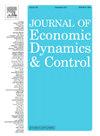健全的税收和债务管理理论
IF 2.3
3区 经济学
Q2 ECONOMICS
引用次数: 0
摘要
考虑考虑模型不确定性并寻求稳健决策的政府的最优税收和借款计划。定量暗示表明,模型不确定性的存在使政府更愿意借贷并扩大其债务能力。在最坏情况下,税收的边际效益和最优税率先降低后增加。这是由于模棱两可所引起的两种对立效果之间的博弈。此外,政府应更多地参与金融对冲,而持有的债务与gdp之比不再是线性的。本文章由计算机程序翻译,如有差异,请以英文原文为准。
Robust p theory of taxes and debt management
We consider the optimal tax and borrowing plan of a government that worries about model uncertainty and seeks robust decisions. Quantitative implications show that the presence of model uncertainty makes the government more willing to borrow and enlarges its debt capacity. Under the worst-case scenario, the marginal benefit of taxation and the optimal tax rate decreases first and then increases. This is due to the game between two opposing effects induced by ambiguity. Moreover, the government should engage more in financial hedging while the amount of holdings is no longer linear in the debt-to-GDP ratio.
求助全文
通过发布文献求助,成功后即可免费获取论文全文。
去求助
来源期刊

Journal of Economic Dynamics & Control
ECONOMICS-
CiteScore
3.10
自引率
10.50%
发文量
199
期刊介绍:
The journal provides an outlet for publication of research concerning all theoretical and empirical aspects of economic dynamics and control as well as the development and use of computational methods in economics and finance. Contributions regarding computational methods may include, but are not restricted to, artificial intelligence, databases, decision support systems, genetic algorithms, modelling languages, neural networks, numerical algorithms for optimization, control and equilibria, parallel computing and qualitative reasoning.
 求助内容:
求助内容: 应助结果提醒方式:
应助结果提醒方式:


